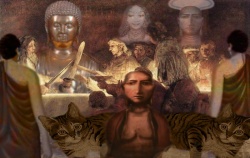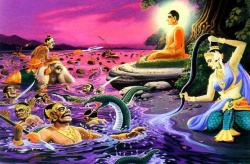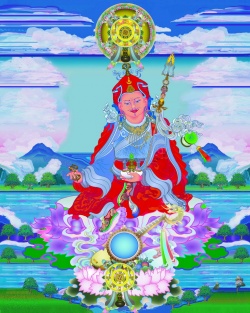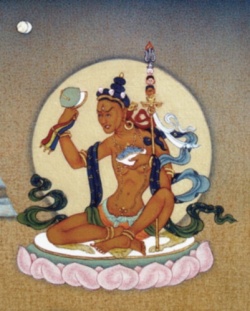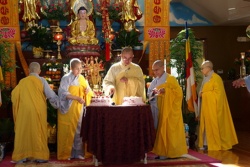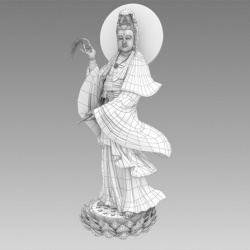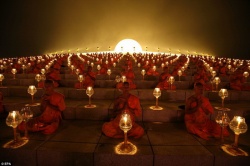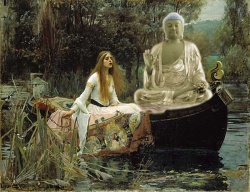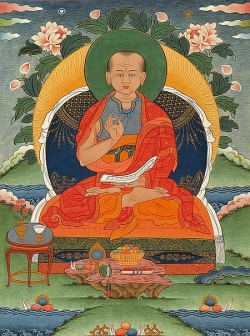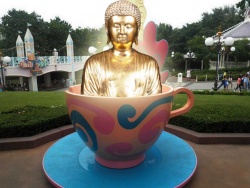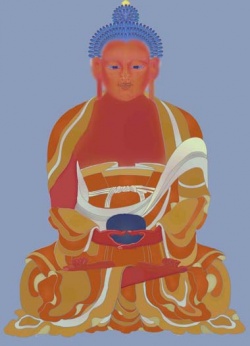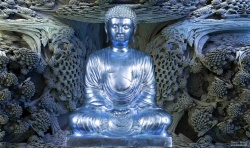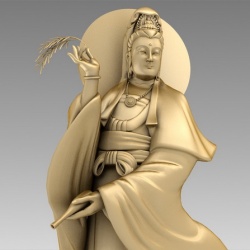Difference between revisions of "The Practice of Prajnaparamita"
| Line 205: | Line 205: | ||
The {{Wiki|syllable}} "om" has many meanings, but generally it begins [[mantras]]. | The {{Wiki|syllable}} "om" has many meanings, but generally it begins [[mantras]]. | ||
| − | "[[Gate gate]]" means gone, gone. "[[Paragate]]" means gone beyond. "Parasamgate" means perfectly gone beyond. "[[Gate]]" refers to the [[path of accumulation]]. | + | "[[Gate gate]]" means gone, gone. "[[Paragate]]" means gone beyond. "[[Parasamgate]]" means perfectly gone beyond. "[[Gate]]" refers to the [[path of accumulation]]. |
This [[path]] can be divided into three parts. | This [[path]] can be divided into three parts. | ||
Revision as of 13:43, 24 December 2015
We have attained a precious human birth, which is difficult to find. This precious human birth we achieved because of past causes and conditions. We have achieved it because of the vows we upheld in previous lives, the practices of the six perfections, and bodhicitta in the past.
As the Tibetan saying goes, if you want to see what actions you have done in the past look at your current life. And if you want to see your future life, look at your current actions.
Knowing this, you should rejoice that you have achieved precious human birth because of your past good deeds. If you maintain a kind mind and engage in wholesome actions, it is sure you will attain a precious human birth in future lifetimes.
At the same time, you might wonder how both practitioners and non-practitioners have achieved the good fortune of a precious human birth. There is a great difference between those who practice and those who do not.
Even if you are born as a human, you may not have the desire or opportunity to practice dharma.
The ten freedoms and eight leisures a practitioner achieves are like a wish fulfilling jewel. Those without them lack the precious jewel of dharma practice. Those who have this, know how to cultivate wholesome actions and avoid negative actions. So it's like dharma practitioners have the wisdom eye and those who do not practice do not.
Practitioners know wholesome actions bring happiness and unwholesome actions bring suffering and pain. Non-practitioners do not hesitate to kill an insect they find in their house.
A spiritual person, even if they have not committed the act of killing, finds it difficult to witness someone killing a fly. A common saying is regret is a strong antidote to purify negative actions.
So feeling regret when observing killing is a strong remedy to purify past wrong doings. Non-practitioners do not know the faults of actions like killing from their ignorance. So Kyobpa Rinpoche said those beings ignorant of the results of wrong doing are worse than animals.
Fundamental ignorance is the strongest affliction beings have. There are also people who disbelieve in the workings of karma and rebirth. They are creating more negative karma through this. They are creating the karma as being reborn as animals.
This is considered as worse than being reborn in hell because their actions in the animal realm will cause them to be reborn in hell.
The hell realm has terrible experiences, but once the karma that leads to them is exhausted, hell beings are born in higher realms. So we should rejoice in our current state and the karma that led to it.
The Shravaka vehicle focuses more on renunciation, the bodhisattva vehicle on bodhicitta, and the Vajrayana on the four turnings of the mind to dharma.
Today we will teach on the Heart Sutra, a sutra from the second turning of the wheel of dharma. There are other Perfection of Wisdom Sutras, such as the 100,000 Verse Prajnaparamita.
In Tibetan it occupies twelve volumes of scripture. The middle length Prajnaparamita has 25,000 verses and occupies three volumes. The most shortened form has 8,000 verses and occupies one volume. This text, the Heart Sutra, is the most concise and contains the essential meaning of all the verses. In other countries the version of the Heart Sutra is different, because it lacks the introductory verses.
I am not well trained in this kind of teaching. The tradition is Tibet is to read the Prajnaparamita as often as you can, so I have read them many times. But this was just the literal reading.
Usually the sponsor invite monks to read them and one reads them quickly, without meditating on the meaning, because if you didn't finish the sponsor would not be pleased. If someone is a fast reader, they are praised.
The text begins with the title in Sanskrit, to pay homage to the translator. Also one respects the language Shakyamuni taught in. So this is the reason for the Sanskrit title. In Tibetan, Indian is called rGya gar, which refers to its central location.
The text begins, "Homage to Transcendent Knowledge."
The reason for the homage is to receive the blessings of wisdom.
The text begins "Thus have I heard: Once the Blessed One ..." In Vajrayana they speak of the five auspiciousnesses: time, place, teacher, teaching, and disciple So "thus have I heard signifies the auspiciousness of time.
"the Blessed One" refers to the auspicious teacher. "Vulture Peak Mountain" is the auspicious place. "Monks and Bodhisattvas refers to the auspicious disciples of the two vehicles. The auspicious teaching is the Heart of Transcendent Wisdom.
The text says, "The Blessed entered the samadhi which examines the dharma called profound illumination." Profound illumination refers to the practice based on the perfection of wisdom.
These practices are done to achieve enlightenment. The dharmas refer to conventional realities.
To realize ultimate reality you must first understand conventional reality.
The text says "Avalokiteshvara looking at the profound practice of transcendent knowledge." Here one is looking at the true nature of reality, where objects are seen as lacking inherent existence.
The text continues, "saw the five skandhas and their natural emptiness." All conventional phenomena and contaminated entities are contained in the five aggregates.
Unwholesome actions, which are their results, occur because if the working of the five skandhas.
Because all conventional things are contained in the five aggregates, once one realizes their emptiness, one realizes the emptiness of all phenomena.
The following sentences are easy to understand.
"Shariputra, how should noble men and women attain profound transcendent knowledge?" Shariputra was the heart disciple of Shakyamuni Buddha. Shari refers to his mother and putra means son in Sanskrit. So his name means son of Shari.
Then Avalokiteshvara responds, "those who wish to practice" This refers to practitioners of both vehicles. "the five skandhas should be seen in their natural emptiness." Skandha refers to a heap of anything.
The first aggregate is form. The text says form is emptiness. When it says this, it doesn't mean nothingness.
Then it says the other four skandhas are emptiness. If it referred to nothingness, the text wouldn't make any sense.
If you ask what emptiness means, all unwholesome actions arise in dependence. Form could be the form of a human body or anything. Form is what is perceived through the senses.
There is nothing wrong in seeing forms. Tilopa said he did not fear of conceiving appearances. But there is a difference between seeing things and grasping to them.
If you see pleasant forms, one gives rise to attachment and does not wish to let go of it. This attachment is a negative action.
When you perceive ugly forms you have hostile feelings and wish not to see these forms. All these feelings come into existence because you do not see the empty nature of the forms.
If you realize the empty nature of forms, there is no possibility of giving rise to unwholesome emotions toward them.
Usually it is said it is not appropriate not to teach emptiness to students before students are introduced to the preliminary practices and the fivefold mahamudra.
Without accumulating a great deal of merit you cannot purify negativities and realize emptiness. This is true, because otherwise we would have realized emptiness earlier.
When you were beginners in the dharma, it probably didn't make sense when you heard about emptiness.
But since you have practiced the four thoughts, it probably makes some sense when you study emptiness. It is said in the time of Shakyamuni some students were shocked when they heard of emptiness.
Without proper guidance and instruction one is in danger of falling into the view of Ha Shang or the extreme view that emptiness is nothingness.
There are teachings where it says wholesome actions and unwholesome actions don't lead to results. These teachings can't be taken literally.
There are also teachings where it is said there is no Buddha and no wisdom. This refers to ultimate realization of Buddha's wisdom.
When Buddha realizes wisdom they don't perceive it as inherently existent. So in the afternoon session we will have questions and continue with the teachings.
Q: How is it that the word dharma can have such different meanings?
A: The word dharma can mean existing things. It also means the spiritual practice.
Q: Could you explain your statement all form arises in dependence?
A: I said the arising of negative thoughts is dependent on forms. Without forms, there would be no attachment or aversion.
Q: Garchen Rinpoche said that when appearances are purified, they arise like rainbows. Could you explain this?
A: Through impure perception, one gives rise to attachment and aversion.
Q: Are form and emptiness identical and is form what appears when we are obscured?
A: Yes. When we say form is emptiness, that refers to the ultimate understanding. The reason why we are unable to realize it is our obscurations.
The important thing to know here is mind is the agent that produces happiness or sufferings. We talked about yogi Milarepa yesterday. From the outside he looked pathetic.
But inside he had supreme joy and happiness. So this is an example of how the mind creates happiness. Milarepa told his sister when she asked him to become a monk's attendant that he could be even more of a worldly success than the lama, but his goal was to achieve supreme liberation.
To explain this more, to a blind person a bowl of yogurt appears dirty (because spoiled?)
A person with sight can explain it is a bowl of yogurt.
What the blind person understood was a misperception. This explains the phrase that form is emptiness and emptiness is no other than form. Nothing about the yogurt changed. It was empty of the misperception.
In the same way we should understand the five skandhas. Feeling is what we experience through the sense of touch. Feeling is emptiness and emptiness if feeling. The same can be said for the other skandhas.
The Heart Sutra says form has no characteristics. Since it is empty of inherent existence, it lacks characteristics. It is unborn. In the Madhyamika it talks about the different aspects of unborn.
Here it refers to its emptiness of true existence. Since it is empty, it is unborn.
Since it is unborn, it also is unceasing and does not abide anywhere or go anywhere. Phenomena are not impure. So once you realize the emptiness of form, there is no grasping to what is impure or pure. You attain purity of mind and supreme bliss.
If phenomena are not pure, the pure and impure cannot be separated.
The text says phenomena do not decrease or increase. This refers to the dharmakaya. Once the mind realizes this, there cannot be any decrease in its realization.
The text continues "since there is emptiness there is no form, ...". The text lists the six inner and outer constituents. Once you realize emptiness, the true nature of reality, you are free of ignorance, since emptiness is the direct antidote to ignorance.
We put this in the context of the twelve links, all which originate from ignorance.
So with wisdom, there is no following of the twelve links. In the same way there is "no wisdom, no attainment, and no non-attainment".
If you realize emptiness you can apply this realization to the path.
But emptiness doesn't mean nothingness and does not imply that there is no need to follow the path. The text says, "Since there is no attainment for the bodhisattvas they abide by means of transcendent knowledge.
" You can come to transcendent wisdom without abandoning the conventional world.
The text continues, "Since there there is no obscuration of mind, they have no fear"
This refers to the two types of meditation. The first is when the mind directly aware of emptiness and the second is post-meditation where you carry this understanding into your daily activities.
When it refers to no fear, this refers to post-meditation. Knowledge of emptiness can free you from all sorts of fears.
The text says, "They transcend falsity and pass beyond the bounds of sorrow"
This refers to the different stages of the path, specifically the path of seeing, where you realize emptiness directly and eliminate the self grasping mind of ignorance. Pass beyond the bounds of sorrow refers to the fifth path, where one is completely enlightened.
Next the text refers to "the mantra of transcendent knowledge, of deep insight, the unsurpassed mantra, the unequalled mantra." This mantra is free of the three faults. Unequalled refers to enlightenment, because nothing is its equal.
The mantra calms all suffering, which refers to the suffering of cyclic existence.
By means of the practice of the perfection of wisdom, one achieves Buddhahood.
The text says that it "Should be known as truth, since there is no deception." The mantra is non-deceptive, because if you practice the perfection of wisdom it will not deceive you.
Practitioners should not have any doubt in their practice. In the middle stage of Shakyamuni's teaching he taught the perfection of wisdom. By going through all the trainings we are removing the gross and subtle obscurations and developing the positive qualities.
Shakyamuni was able to achieve enlightenment and realize his Buddhahood. He was able to bring extensive benefit to sentient beings of various levels. All these achievements were actualized by relying on the practice of the perfection of wisdom.
"Tadyatha" means "as such" and refers to all the trainings of the Buddha. The syllable "om" has many meanings, but generally it begins mantras.
"Gate gate" means gone, gone. "Paragate" means gone beyond. "Parasamgate" means perfectly gone beyond. "Gate" refers to the path of accumulation.
This path can be divided into three parts.
Anyone who achieves enlightenment must go through the five paths. The second "gate" refers to the second path, the path of preparation, which has four levels.
"Paragate" refers to the path of seeing "Parasamgate" refers to the fourth path, the path of meditation. "Bodhi svaha" refers to the fifth path, the path of no more practice. The text continues "This is how a bodhisattva should learn profound transcendent knowledge."
We haven't gone through the Heart Sutra thoroughly because of lack of time.
To realize emptiness one has to go through the preliminary practices. To realize mahamudra you must meditate with the single pointed mind of shamatha, both with and without signs.
You can realize emptiness by the practices of the Six Yogas of Naropa, and by the unified practice of bliss and emptiness. So these are the main paths to the realization of emptiness.
There can be exceptional cases where beings can realize emptiness without much training due to their past merits.
But to just talk about the mere words of the doctrine of emptiness does not bring much benefit. One should observe karma and accumulate merit.
If you follow these paths and trainings, realizing emptiness is not such a big deal. You should combine compassion with the wisdom of emptiness.
The higher your realization becomes, the more concern should be given to the law of karma. This comes naturally when you understand the deeper nature of emptiness.
Q: Could you list the six perfections?
A: Generosity, moral discipline, patience, perseverance, meditation, and wisdom.
Q: What are the three trainings?
A: Vinaya, meditation, and wisdom.
Q: And the five paths?
A: Accumulation is the accumulation of merit. The next is the path of preparation. By practicing it, you come to the path of seeing, which is the third path. The fourth path is divided into the ten bhumis. The you reach the fifth path, path of no more learning, which is complete enlightenment.
Q: What is the difference between liberation and enlightenment?
A: in liberation one gains freedom from one's negative actions and thoughts. It's like arhatship.
Q: Are enlightenment and Buddhahood the same and do they depend on practicing the six perfections?
A: Without cultivating all the merits you cannot achieve enlightenment. Enlightenment and Buddhahood are the same.
Q: Could you talk about individual and collective karma?
A: The human realm is a result of our collective karma. As regards to national karma, the achievements and activities of the nation are the result of the karma of the individuals of the nation. The individual experience of pleasure and pain are due to individual karma.
Q: Is it true to say without untying the knots of the nadis one cannot go beyond the bounds of sorrow?
A: That's true, you cannot attain enlightenment without loosening the knots. But this cannot be correlated with a specific path. It depends on the individual.
Q: Do you practice the perfections in the order they are presented?
A: In one way they occur in order. But each perfection includes the others.
Q: How do you deal with people who complain about their karma?
A: Help them by sharing their suffering and adversity. Enhance your own practice so you have the ability to help them.
Q: At what point in the path does the teacher help you overcome fear?
A: All fear arises from the misapprehension of self grasping mind. So by overcoming this one overcomes fear. Once you apprehend the true nature of reality, you are free of fear. You cannot find fear in emptiness any more than you can find cold in fire. When you have fear, you lack the understanding of emptiness.
Q: At what point is karma gone?
A:When you actually attain enlightenment.
Source
http://medicinebuddhasangha.org/teachings/prajnaparamita.html
